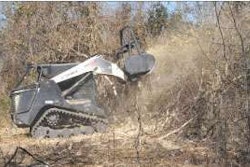Concrete ‘Road Map’ Not Set in Stone
Stakeholder Needs Take Concrete ‘Road Map’ in New Directions
By Tom Kuennen, Contributing Editor
The CP Road Map, formally the Long-Term Plan for Concrete Pavement Research and Technology – first articulated to the industry at the Transportation Research Board meeting in January 2006 – is fine-tuning its direction and experiencing a few course corrections as research meets reality in a changing environment for concrete pavement studies.
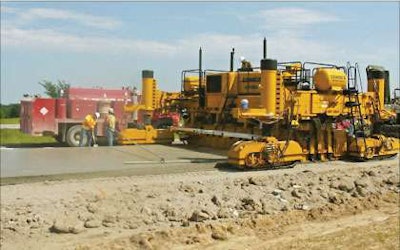 On I-35 near Kearney, Kan., stringless technology is resulting in a super-smooth pavement for the Kansas DOT.
On I-35 near Kearney, Kan., stringless technology is resulting in a super-smooth pavement for the Kansas DOT.The refreshed program is symbolized by a new logo which demonstrates how different pieces of a puzzle come together to form a solid pavement.
Under the aegis of the National Concrete Pavement Technology Center (National CP Tech Center) at Iowa State University – which provides operations support services to the CP Road Map program – the CP Road Map is in the fourth year of a 10-year strategic plan that outlines approximately $250 million in needed concrete pavement research.
While the CP Road Map articulates a broad variety of research needs, local budgets and sheer necessity has curtailed the scope of ongoing research activity from coast to coast.
Now, seven active tracks (of 13 total) are active, dubbed Priority Tracks in the CP Road Map literature. These are:
Track 1: Performance-Based Concrete Pavement Mix Design System
Track 2: Performance-Based Design Guide for New and Rehabilitated Concrete Pavements
Track 3: High-Speed Nondestructive Testing and Intelligent Construction Systems
Track 4: Optimized Surface Characteristics for Safe, Quiet, and Smooth Concrete Pavements
Track 7: High-Speed Concrete Pavement Rehabilitation and Construction
Track 11: Concrete Pavement Business Systems and Economics, and
Track 13: Concrete Pavement Sustainability.
In abeyance in 2010 are:
Track 5: Equipment Automation and Advancements
Track 6: Innovative Concrete Pavement Joint Design, Materials and Construction
Track 8: Long-Life Concrete Pavements
Track 9: Concrete Pavement Accelerated and Long-Term Data Collection
Track 10: Concrete Pavement Performance, and
Track 12: Advanced Concrete Pavement Materials.
Environmental Sustainability
Even as some tracks fell into abeyance, in 2007 a new priority track was instituted – Concrete Pavement Sustainability.
“A couple of years ago, our executive committee decided that we needed to focus on sustainable engineering products, and to develop an additional track for the Road Map that put real focus on environmental sustainability,” Cackler told Better Roads. “There is a lot of individual research that is cross-cutting among all our tracks, but we were able to extract those to specifically ensure that sustainable concrete pavement practices were being addressed in its own track.”
The Road Map is a living document that should not be carved in stone, but should be altered to include new tracks like sustainability, Cackler said. “It’s an agile Road Map that can adjust to needs,” he said. “Right now, we are taking a similar approach that will address rehabilitation and maintenance, which is important because of the financial bind that agencies are in right now.” But the program will be enlarged in the future.
The sustainability topic is so “hot” right now that an International Conference on Sustainable Concrete Pavements: Practices, Challenges and Directions will be held Sept. 15–17 in Sacramento, Calif.
Organized by FHWA and the National Concrete Pavement Technology Center, and cosponsored by a variety of other organizations, including AASHTO, the conference will provide an international forum in which to discuss the sustainable attributes of concrete pavements via existing technologies, emerging research, approaches to measuring energy and environmental impact, user needs, and international practices and experience.
Briefing on Concrete Sustainability
In August 2009, the Road Map published a 48-page briefing document, Building Sustainable Pavements with Concrete. Written by the National Concrete Pavement Technology Center’s Dr. Peter Taylor, P.E., and Dr. Thomas Van Dam, P.E., Applied Pavement Technology, Urbana, Ill., the document may be downloaded at www.cproadmap.org/publications/sustainability_briefing.pdf.
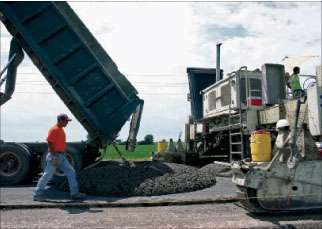 Thin concrete overlay is placed in Story County, Iowa.
Thin concrete overlay is placed in Story County, Iowa.“It’s just one of the products that have been developed,” Cackler said. “We are also developing a manual of practice that will give agencies guidance on specific technologies for building sustainable pavements. The briefing document is only the initial product from this track.”
The briefing is intended to communicate sustainability concepts and practices to the concrete pavement community, in order to effect positive economic, environmental, and social change, the authors said.
“Many intrinsic characteristics of concrete make it a relatively sustainable material for pavements,” Van Dam and Taylor write. “Many concrete-based solutions for new and existing pavements have elements that may improve the sustainability of a pavement system. Moreover, implementing sustainable pavement solutions helps owner agencies address their pavement performance and budget challenges, because cost-effectiveness and high performance are integral [to] sustainable solutions.”
The briefing articulates seven “common-sense principles” regarding sustainable concrete pavements and their implementation. They are:
* Get Smart. The concrete community should not be content with the status quo; instead it should become educated about how to make concrete pavements an integral part of sustainable infrastructure, including the embrace of the concept of pavement life cycle.
* Design to Serve the Community. Context-sensitive design entails meeting the needs of not only the user, but also the adjacent communities and the environment. For example, road builders strive for the smoothest, most-efficient surface, yet a locality may want a rough surface to “calm” traffic. Designers need to get the local needs straight.
* Choose What You Use. Look beyond simply meeting long-established concrete pavement specifications, the automatic application of which year after year creates a barrier to the acceptance of rapidly evolving sustainable practices, such as enhanced use of recycled concrete aggregate (RCA).
* Less is More. Another common-sense principle of sustainable design is “less is more.” Other factors being equal, a design that uses less virgin material is generally more sustainable.
* Minimize Negative Impact. The industry is urged to incorporate construction and operational designs that directly contribute to the sustainability of concrete pavement, including noise from construction and from traffic; safety during wet weather and night driving; delays during new construction and during rehabilitation; pollution, particulates and waste generated by construction and traffic; water use and treatment of run-off such as sawing slurry; energy efficiency of construction, traffic operations, and urban lighting; and mitigation of the urban heat island effect, in which higher temperatures exist over built-up urban areas. “Sustainable practices can be as basic as maximizing the efficiency of haul trucks,” they write.
* Take Care of What You Have. The concrete industry should embrace active pavement preservation principles – such as diamond grinding – to prolong concrete pavement life and delay disruptive reconstruction through multiple cycles, and
* Innovate. “Adopting a sustainable approach to pavements requires agencies and industry to develop new ways of thinking and doing,” Van Dam and Taylor write. “We can no longer base decisions on economic impacts alone, especially first costs. We must consider environmental and social impacts as well, spanning the entire pavement life cycle. Developing win-win-win solutions challenges our abilities to create and innovate.”
Performance-Based Mix Designs
Environmental sustainability notwithstanding, the CP Road Map’s No. 1 priority has been the shift to performance-based mix designs, and that’s the topic of Track 1: Performance-Based Concrete Pavement Mix Design System.
As the industry shifts from one-size-fits-all “prescriptive” concrete mix designs to those that are optimized for performance, stakeholders need guidance as to how that can come about. For example, this year a pooled fund study is underway that will study mix proportioning and set times, and includes Iowa, Kansas, Michigan, Missouri, New York, Oklahoma, Texas and Wisconsin. It joins a variety of other projects in this track.
And in May 2010, in support of Road Map Track 1, Performance-Based Concrete Pavement Mix Design Systems, the CP Road Map released Moving Advancements into Practice (MAP) Brief 1-1: Job-Specific Optimization of Paving Concrete with COMPASS.
This brief familiarizes end-users with FHWA’s Concrete Mixture Performance Analysis System (COMPASS), a Windows-based application that uses a proven statistical mix optimization approach, and includes many practical features and analysis techniques to help users optimize concrete mixtures.
With COMPASS, a user can optimize the performance of a concrete mixture in a particular environment by properly selecting material constituents, such as types of aggregates, cementitious materials, and admixtures, that will benefit properties identified as important to a particular environment, project type, and degree of importance of the project.
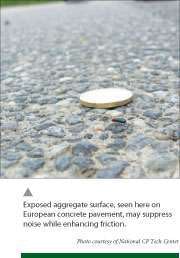
“We have been working with track leadership regarding how can they model mixes for optimization, including COMPASS,” Harrington told Better Roads. “We have been working to publicize that through the Road Map.”
But it’s very much a team effort, Harrington said. “Our track leadership involves many different agencies, and also private sector industry,” he said. “With the exception of what we do at the national center, the CP Road Map encourages, but does not have influence over the research.
“What’s more fair to say is that through the communications of the CP Road Map, the committee structure and the executive committee,” Harrington added, “researchers get an understanding of where the priorities are, where there is need, and then due to their funding abilities, go out and execute the research, in this case COMPASS.”
Mechanistic Design
In the wake of the new Mechanistic-Empirical Design Guide for New and Rehabilitated Pavement Structures, via Track 2: Performance-Based Design Guide for New and Rehabilitated Concrete Pavements, the CP Road Map is working to ease the transition to the mechanistic guide on behalf of agencies that specify concrete pavements.
The track’s mission is to enhance the next generation of mechanistic approaches to pavement design, and improve their integration with materials, construction, and environmental inputs. A major element of the track is helping agencies and contractors successfully make the change from strictly empirical design approaches to mechanistic approaches.
“The need has been recognized,” Cackler said. “Millions of dollars are being expended as states work on the implementation of the guide. We’ve done a couple of things: We are working with both FHWA and the National Center for Asphalt Technology on the design guide implementation team on a series of regional forums. But our real emphasis is on the area of concrete overlays.”
Concrete overlays are a priority area because of the need for a very durable, but low-cost, solution to rehabilitation, Cackler said. “The design procedures are not well-defined for concrete overlays, and by the end of the year the Road Map should have a product out on the best software available and design examples for concrete overlays.”
Intelligent Paving
For Track 3, High-Speed Nondestructive Testing and Intelligent Construction Systems, the Road Map is planning to provide assistance and technology deployment on these high-tech essentials, especially in the area of automated paving and GPS guidance systems.
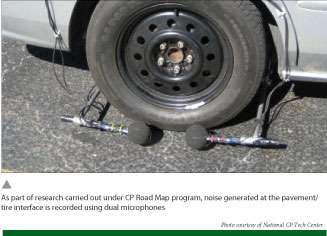
“There are broad applications in a number of areas,” Cackler said. “We’re extending that technology to stringless paving, incorporating technologies on paving equipment that will assess surface characteristics, and real-time smoothness information. As you get away from stringline control, and get to stakeless technology, we will be able to build smoother concrete pavements by eliminating that whole process.”
Optimized Surfaces
For Track 4, Optimized Surface Characteristics for Safe, Quiet, and Smooth Concrete Pavements, the Road Map has been looking closely at pavement texture regarding noise, friction, splash and spray.
“Over the last four years, there has been a national effort to characterize the different kinds of concrete pavement surfaces, whether they be drag-textured, burlap, tined or diamond-ground,” Cackler told Better Roads. “We’ve even looked at some of the European exposed-aggregate surfaces. We’re trying to associate the texture and its characteristics with the acoustical qualities of that texture. The goal is to find out what makes quiet pavements quiet, and noisy pavements noisy, yet optimize that information for frictional qualities. That work is ending this year and we are working on deploying that knowledge and specification guide late this year or early 2011.”
All pavement textures associated with concrete can be very quiet or noisy, he added. “It all depends on the technique, which is based on process control,” Cackler said. “We now can work with contractors and agencies to make sure they understand that there is no reason to have concrete pavement that is not very quiet as well as very smooth.”
In October 2009, in support of Track 4 of the CP Road Map, Concrete Pavement Surface Characteristics, the Road Map released MAP Brief 4-1, Diamond Grinding to Reduce Tire-Pavement Noise in Concrete Pavements. It, and other CP Road Map publications, may be downloaded at www.cproadmap.org/publications/.
High-Speed Rehab, Construction
Some of the activity regarding overlays also carries over to Track 7: High-Speed Concrete Pavement Rehabilitation and Construction. “If you have a pavement in need of rehabilitation, perhaps placing a concrete overlay on it may be the appropriate thing to do,” Cackler said. To this end, a Concrete Overlay Field Application program has been active, with field visits in 2009 to Delaware, Pennsylvania, Washington State, Nevada, West Virginia, Texas and New Mexico, and, in 2010, to Georgia and Minnesota. Visits to North Dakota, Virginia, Illinois and Indiana were planned for July 2010.
“We want to increase awareness of the tools for concrete pavement rehabilitation, and have worked with FHWA on training materials,” Cackler said. “We want to share with public agencies their best option for addressing pavements in distress.”
Regarding high-speed construction, the Road Map is looking at in-situ processing of materials. “There is an expanded use of in-situ material process on construction sites, and there is a real trend toward reuse of material that will save tremendous amounts of time,” Cackler said. The recyclability aspect also feeds into the sustainability theme.
In the meantime, the Road Map released MAP Brief 7-1: Use of Nonwoven Geotextiles as Interlayers in Concrete Pavement Systems. MAP Brief 7-1 describes the potential use in the United States of nonwoven geotextile materials as interlayers in concrete pavement systems, particularly unbonded overlays. Starting with experience gained in Germany, MAP Brief 7-1 discusses the availability and cost of nonwoven geotextiles in the United States, specifications, recent field tests, recommended construction practices and research issues.
Business Systems and Economics
For Track 11: Concrete Pavement Business Systems and Economics, the executive committee of the Road Map is trying to identify, from the business side, any barriers to how an agency specifies or bids paving products.
“There has been a lot of growing interest into alternate bidding, and life cycle assessments, and this particular track is dedicated to identifying any barriers to concrete, or education or communication needs, that would enhance concrete use,” Cackler told Better Roads. “A lot of activity in that area has taken place at the state DOT level, and we are now evaluating what communications pieces might be needed to deploy in this area.”
Thus, research is underway to evaluate the impact of alternative bidding for asphalt-concrete solutions, and to evaluate the effectiveness of incentives. Also, “webinars,” blogs, and other web-based methods are being utilized as outreach mechanisms, especially as agency travel to conventional conferences and workshops is curtailed in light of budget cuts. The team also has made significant progress in developing effective accelerated technology transfer and rapid education programs for the future concrete paving workforce.v
PLUS DIGITAL EXTRA
If this story is valuable to you, go to our DIGITAL EDITION (at www.Better Roads.com) – page 33a – to look into the history and operational details of the Concrete Pavement Road Map of Research.
Concrete ‘Road Map’Is A New Model For Funding And Research
With the exception of research taking place at Iowa State’s National CP Tech Center, neither the CP Tech Center nor the CP Road Map actually fund or direct the research. Instead, under the management of the National CP Tech Center, the CP Road Map coordinates and helps program research activity nationwide to ensure its relevance, avoid redundancy, and deploy technology to those who can use it in the field.
In September 2005, the CP Road Map set forth 12 tracks of research that would define concrete pavements of the 21st century. Now, in 2010, six of the original 12 research tracks are active, with the others awaiting funding or activity.
And to meet the demands of the environmental age, a 13th track, Concrete Pavement Sustainability, was added and is very active as building materials compete and define their environmental profiles.
“When the Road Map was originally developed, it was a consensus document that represented public agency and industry strategic needs,” said Tom Cackler, P.E., CP Road Map principal administrator. “It was intended to identify the needs that had to be addressed. We identified priority tracks because the resources to support the Road Map, like all things in our industry, were revenue-constrained, so our executive committee decided on certain tracks that would make the biggest initial difference. Those became our priority tracks.”
The CP Road Map is a facilitator, not a funder of research. “We are not really a funder of research,” Cackler said. “We are trying to advance research nationally, in a coordinated way, and to boost technology deployment.”
Research work continues on industry themes that are described by Road Map tracks that are in abeyance, of course, but it’s not part of the CP Road Map structure.
“The priority track leadership teams work with us on a quarterly to semi-annual basis,” said Dale Harrington, P.E., CP Road Map project manager. “The non-priority tracks don’t have those team leaders. However, when things occur within those other tracks, we deal with them when we can. But our real emphasis is on the priority tracks that our executive committee feels need to be emphasized.”
Now that the program is firmly under way, attention is shifting from research structure to transfer of technology to the end user. “We now are focusing more strongly on technology deployment and dissemination of information,” Cackler told Better Roads. This is taking place through the release of Moving Advancements into Practice (MAP) briefs, which describe promising technologies that can be used now to enhance concrete paving practices, other briefing documents, and monthly e-newsletters which spotlight practical Road Map-related research around the country.
Radical Change Prompted Road Map
The Road Map was developed as a response to radical change in concrete pavement technology in the last two decades. It’s intended to facilitate the reinvention of concrete pavement systems to deliver 21st century results, with a goal of presenting a comprehensive, functional and integrated suite of concrete pavement technologies.
To this end, a team led by Iowa State University, and sponsored by the Federal Highway Administration, conducted five major brainstorming sessions with stakeholders across the country between October 2003 and October 2004. More than 400 stakeholders participated, representing state and local DOTs, the American Association of State Highway and Transportation Officials, FHWA, the American Concrete Pavement Association (including some state chapters), the Portland Cement Association, the National Ready Mixed Concrete Association, and other groups. They articulated research needs in mixes and materials, pavement design, construction, and pavement management/business systems.
The team compared critical needs identified by stakeholders with a database of recent, current, and planned concrete pavement research. Obvious gaps not being filled by existing research became problem statements in the CP Road Map. The problem statements were categorized by track and sub track, and critical links between them were established.
As a result, the Road Map combined more than 250 research problem statements from state, local, federal, and private sector stakeholders into 12 fully integrated and sequential tracks of research which were hoped would lead to specific products that would dramatically affect the way concrete pavements are designed and constructed (see Concrete Pavement’s New Road Map, March 2006, pp 52-65).
Uniquely, the CP Road Map has no tie to one agency or funding source. Instead, the Road Map represents a new business model for funding and sharing research in which stakeholders voluntarily align opportunities to pool funds and intellectual resources in ad hoc research collaboratives, sharing administrative costs.
Today, the CP Road Map team is headed by Tom Cackler, P.E., National CP Tech Center, principal administrator; Dale Harrington, P.E., Snyder and Associates, project manager; and Dr. Peter Taylor, P.E., associate director of the CP Tech Center. v

